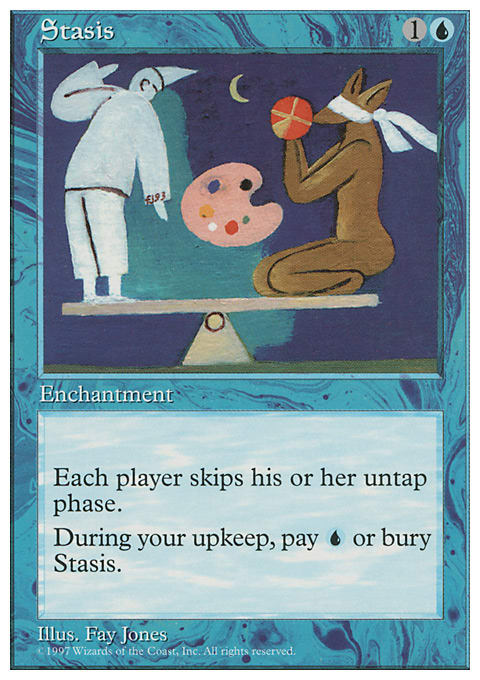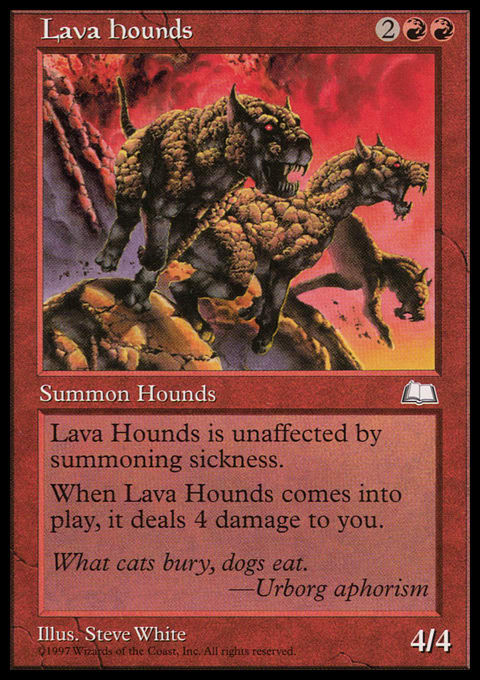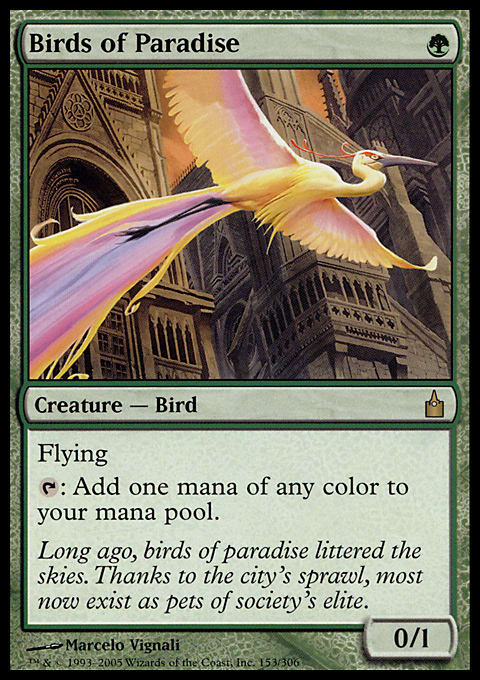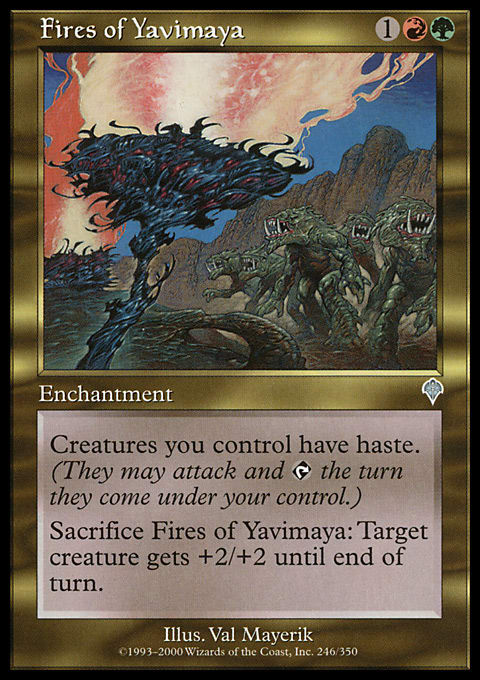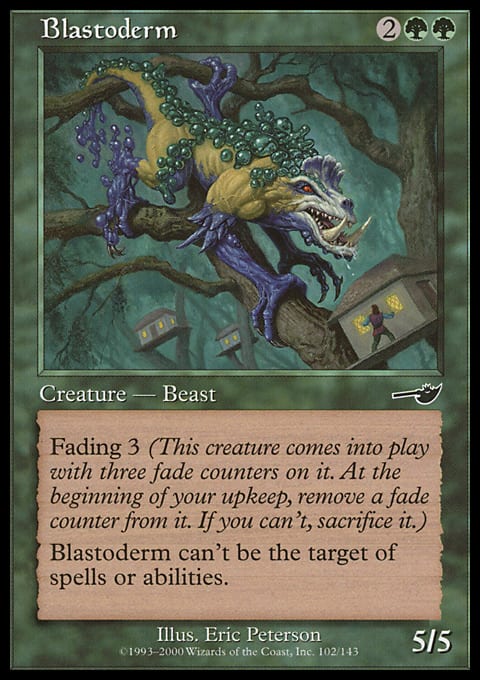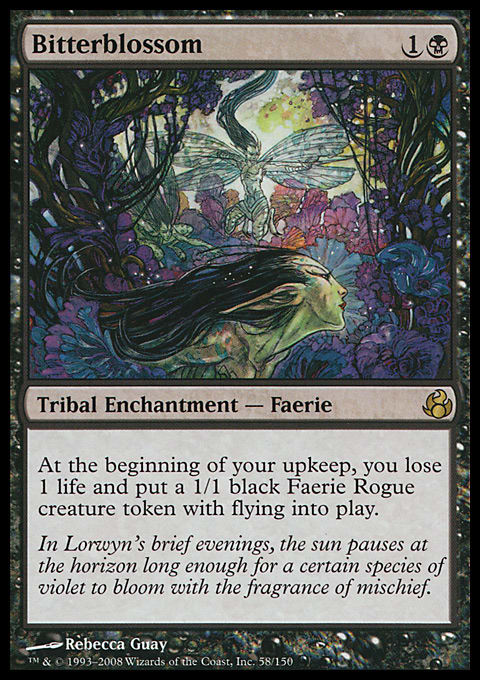I often get nostalgic around this time of year. So... Nothing about how you can burn a Lava Dart for damage (especially Prowess damage) early while still insulating yourself from Lightning Skelemental damage or anything like this week. Oops.
Rather, I thought about how we had so g-d many cards banned and nominally oppressive decks rise (and, you know, get banned) this year. But I can tell you, as un-fun as Wilderness Reclamation with Teferi, Time Raveler was to play against... It was kind of nothing new. We've always had decks we didn't want to play against. And for my part? A heck of a lot more hateful than the 2020 crop.
Here's to my Top 8:
1. Turbo Stasis
How old were you in the summer of 1996?
Yeah... That's what I thought.
For my part, I was twenty already (meaning my joints had already started to ache when I got up in the morning), but my tournament Magic career was less than a year old.
In the summer of 1996, most people still played decks that they made themselves, or brewed with their friends over the kitchen table... Even when they were playing in tournaments. Most people did. But some were downright mean-spirited. So, everyone was mean to them.
"Netdeckers"
It probably seems odd to you as a late 2020 reader, but folks who got their decks off the interNET - and then had the gall to play such rather than decks they made for themselves - were loathed in many circles. More successful tournament-wise, maybe, but loathed.
My first experience against one such was in late summer. I was actually at Origins that year as the Turbo Stasis deck was coming together... I distinctly remember my friend Worth Wollpert - who was qualified for Pro Tour Columbus - trying to find Despotic Scepters. But I never played against the deck until after it had become public knowledge.
Turbo Stasis | 1996 Standard | Matt Place
- Instants (16)
- 4 Arcane Denial
- 4 Boomerang
- 4 Force of Will
- 4 Lim-Dûl's Vault
- Sorceries (2)
- 2 Recall
- Artifacts (10)
- 1 Feldon's Cane
- 1 Ivory Tower
- 1 Zuran Orb
- 3 Despotic Scepter
- 4 Howling Mine
- Lands (25)
- 13 Island
- 4 Adarkar Wastes
- 4 City of Brass
- 4 Underground River
- Sideboard (15)
- 1 Kismet
- 1 Black Vise
- 2 Blue Elemental Blast
- 2 Disenchant
- 2 Hydroblast
- 1 Lodestone Bauble
- 3 Mana Short
- 1 Swords to Plowshares
- 2 Wall of Air
Turbo Stasis became one of the all-time legendary decks at US Nationals that July. 50% of the US National Team was made up of Turbo Stasis players. The great Matt Place and the infamous Mike Long.
Beyond multiple high finishes, Turbo Stasis had a ton of overlapping pedigree. It was maybe the first lock combo deck to perform at a high level. It was also a brilliant metagame deck.
The de facto "best deck" of the Standard format at that point was Mono-Black Necropotence. A deck that was designed to tap all its mana every turn (usually at sorcery speed). Such a deck could fall right into the clutches of the lock deck's signature card:
Howling Mine (the "turbo" in Turbo Stasis) blunted the random violence of a first turn Hypnotic Specter or second turn Hymn to Tourach. At the same time, it allowed Turbo Stasis to keep pace with Necropotence itself - and better. Necropotence players, with no draw steps, did not get the extra cards; at the same time, Turbo Stasis did not pay life for them. Finally, it was a way to win.
Say what you want about fast beatdown... I don't think there is much more oppressive for a relatively inexperienced player to go up against than a tuned Stasis deck. Only one Planeswalker at the table actually gets to play... And even then, barely. If you count drawing 2-3 cards, playing an Island, and upkeep Stasis as playing.
For the life of me, I can't remember if I won or lost against the Stasis mage back in the summer of 1996. I played a looooot of Disenchant-types back then, so maybe I won. But it likely wasn't any fun.
2. Deadguy Red
It has been said that the last man to truly understand all the technology he used every day was Leonardo Da Vinci. He died 501 years ago.
Despite being much narrower than "everything, every day" the same can be said for the average Magician: Few understand the technology that drives their decks, even when they can ape the proper play patterns and make winning decisions.
Magic - and the understanding of it - has progressed tremendously since the summer of 1997. We were really a bunch of stumbling nincompoops, say 23 years ago. Consider Dave Price's Standard deck from US Nationals:
Deadguy Red | 1997 Standard | David Price, US Nationals 1997
- Creatures (23)
- 2 Dwarven Soldier
- 2 Viashino Sandstalker
- 3 Goblin Digging Team
- 4 Ball Lightning
- 4 Goblin Vandal
- 4 Ironclaw Orcs
- 4 Lava Hounds
- Instants (8)
- 4 Fireblast
- 4 Incinerate
- Sorceries (7)
- 3 Kaervek's Torch
- 4 Hammer of Bogardan
- Lands (22)
- 18 Mountain
- 4 Dwarven Ruins
- Sideboard (15)
- 3 Pyrokinesis
- 4 Straw Golem
- 4 Detonate
- 4 Anarchy
Dave had such a poor Limited record that even if he posted a perfect 6-0 on Day Two he could not make Top 8. But he went to the trouble of building and tuning the best deck so he played anyway... And proved that a perfect 6-0 would not earn him Top 8.
This deck was baffling for many. We had already seen Patrick Chapin make Top 8 of the Dallas Juniors with an early "Sligh" deck. And Dave himself had been christened the Fire God at a Philadelpha area PTQ, beating Wildfire Emissaries with Goblin Tinkerers in the two-slot finals.
His summer 1997 deck was in some sense not totally new; as he had already been beating better cards with red ones for a while. But this card?
With 23 years of hindsight, we can see a lot of what made that such a good contributor to the best deck.
- Thawing Glaciers was really popular. Tons of haste creatures - especially hard-hitting ones - could exploit lands that came into play tapped.
- Ice Age was briefly reintroduced to Standard. Swords to Plowshares offset the damage Lava Hounds did to Dave; and Contagion didn't even take it down entirely.
- With 4 toughness, Lava Hounds was outside the range of Incinerate or Hammer of Bogardan
- When you're the beatdown, the four damage might not matter at all.
But back then?
It was just hard for some Magicians to wrap their heads around playing a creature with such a severe downside. For my ignorant part, I had four of these in my "version":
Talruum Minotaur was a performer from Mirage Visions Block Constructed... Hit a little less hard, was way more vulnerable to removal... But also didn't smash yourself for four.
Deadguy Red 1997 was not just difficult to understand. It was difficult to accept. It sucked to lose to it... Especially when you couldn't get what made it so good. You could be playing a White Weenie deck and lose to it! (I know I did.)
By summer of 1998 Dave upgraded to Nationals Top 8; had already won a Pro Tour with Block Mono-Red; Mono-Red was widely acknowledged as the best deck in Standard; and the tournament itself was won by a deck packing four Freewind Falcon.
Yes. In Constructed. Yes. Four.
... But in 1997? It was tough all around.
3. Fires of Yavimaya
"The Fix is in."
That's what people would say when they encountered a first turn Birds of Paradise or Llanowar Elves, followed by a second turn Fires of Yavimaya, then a Blastoderm, and finally a Saproling Burst.
Michael J. Flores - sorry Mike Flores - in 2001 was still at least spiritually a Black mage. In 1999 I had missed the Top 8 of US Nationals on breakers and in 2000 my friend Jon Finkel had won the whole shebang with Mono-Black Napster.
So, I hated trying to build against Fires.
The problem was that the game was often decided on the first turn if they had an accelerator. This was doubly true if they also went first.
Fires of Yavimaya made sorcery speed removal look really bad; and both Blastoderm and Saproling Burst resisted removal anyway. In his My Fires build, Zvi Mowshowitz resorted to Assault // Battery to try to deal with the 1-drop accelerators on-speed. There really weren't great removal options.
The truth is, Fires could be out-built. Zvi performed at a high rate against the archetype he helped put on the map with ![]()
![]() Control at Nationals that year. And Worlds was actually taken down by a b-r disruption deck. Rebels was actually great against Fires, and Kai Budde started really getting settled into his legend winning the PT with a Rebels deck that could weather The Fix.
Control at Nationals that year. And Worlds was actually taken down by a b-r disruption deck. Rebels was actually great against Fires, and Kai Budde started really getting settled into his legend winning the PT with a Rebels deck that could weather The Fix.
But for a Black mage trying to contend with Blastoderm with Vendetta?
I found this a very restrictive foe.
4. Upheaval-Tog
Speaking of restrictive foes.
Wow.
Psychatog | 2002 Standard | GP Milwaukee Top 8
- Creatures (8)
- 4 Nightscape Familiar
- 4 Psychatog
- Instants (23)
- 3 Memory Lapse
- 4 Circular Logic
- 4 Counterspell
- 4 Fact or Fiction
- 4 Opt
- 4 Repulse
- Lands (24)
- 10 Island
- 3 Swamp
- 1 Cephalid Coliseum
- 2 Darkwater Catacombs
- 4 Salt Marsh
- 4 Underground River
- Sideboard (15)
- 1 Deep Analysis
- 4 Exclude
- 4 Gainsay
- 4 Ghastly Demise
- 2 Lobotomy
This was a version of Psychatog played to a Grand Prix Top 8 by eventual two-time Pro Tour Champion Brian Kibler during one of his then frequent-if-brief returns to the game.
Because we were children Brian added Deep Analysis to the sideboard (all of one) just so he could call his deck DeepAnalProbe. Children, we were.
This deck obviously had lots of card advantage, from that solo Deep Analysis to the three Probes to Fact or Fiction, of course. Tog was the quintessential damned if you do / dammed if you don't opponent. You couldn't easily attack it straight up. Psychatog actually just beat most creatures in combat. If you didn't find a way to win in the first seven or so turns it could just get to 8-9 mana, cast Upheaval, float, and cast Psychatog.
The Tog would be so big from your Upheaval-rebuilt hand (and discard-fueled) graveyard that it could one shot almost anyone.
This was an even more restrictive deck to build against than Fires; because if they got their plan, they basically always combo-killed you. And this is on top of having a very good Standard card advantage / control game PLUS a lopsided reset in Upheaval.
Tog decks various added to the legends of not just Hall of Famer Kibler, but the likes of Kai Budde and Carlos Romao. Woe to the mere mortal sitting across the table.
5. Faeries
Faeries | 2008 Standard | Paulo Vitor Damo da Rosa
- Creatures (15)
- 3 Vendilion Clique
- 4 Mistbind Clique
- 4 Scion of Oona
- 4 Spellstutter Sprite
- Instants (12)
- 4 Cryptic Command
- 4 Rune Snag
- 4 Terror
- Sorceries (4)
- 4 Ancestral Vision
- Enchantments (4)
- 4 Bitterblossom
- Lands (25)
- 4 Island
- 2 Faerie Conclave
- 2 Sunken Ruins
- 3 River of Tears
- 4 Mutavault
- 4 Secluded Glen
- 4 Underground River
- 2 Pendelhaven
- Sideboard (15)
- 3 Bottle Gnomes
- 3 Damnation
- 2 Murderous Redcap
- 3 Razormane Masticore
- 4 Thoughtseize
Hands down this is my least favorite archetype to play against, ever.
As countless words have already been devoted to it, I will simply include three anecdotes.
6. Hoofprints of the Stag
I'm guessing you didn't know what that card was off the top of your head.
And yet!
It is almost single handedly responsible for the greatest lapse in Development, ever.
You see, Hoofprints of the Stag is an Elemental.
So of course, for aesthetic symmetry's sake, they made Bitterblossom a Faerie.
Why does that matter?
Because of Mistbind Clique.
WotC actually went out of their way to make cards to fight Faeries. There were angle shots against it, like Cloudthresher or Jund Charm; and direct attacks on its core strategy, like Volcanic Fallout.
Any such sweeper - and especially an un-counter-able one like Volcanic Fallout - should theoretically punish a mislaid Mistbind Clique. EXCEPT BITTERBLOSSOM WAS A FAERIE. So, even when all the Faerie creatures died, the Faerie enchantment wouldn't... Giving Mistbind Clique something to Champion.
- OF COURSE I hated Faeries. I lost to it incessantly. I lost to it in the last round of Swiss at the first SCG Open I ever played, playing a BLIGHTNING BEATDOWN deck! Bitter? Maybe. Like the Awesome Blossom. Doesn't change the fact that it is Magic's greatest, most illogical, lapse in Development, ever.
- A year after Ancestral Visions rotated, Paul Cheom made Top 8 of US Nationals with a Dimir Faeries playing Shadowmage Infiltrator as its primary card draw. On a lark, I made the deck on MTGO and screwed around with it for one night. I called up my friend BDM. It's not that I think my win percentage really went up... But my God, the games I did win were so comparatively effortless. A good ten years into my tournament career, that was the first time I ever felt - actually felt - what it was to be running "the best deck" instead of an anti-deck, or brew.
7. Thopter-Depths
Gerry Thompson had been both highly creative and laboring away for some time before really cementing his reputation as one of the top deck designers in the game. He did it with what was conveniently one of the most important and inventive decks of all time:
Thopter Depths | Gerry Thompson
- Creatures (8)
- 4 Dark Confidant
- 4 Vampire Hexmage
- Instants (11)
- 1 Doom Blade
- 1 Into the Roil
- 1 Slaughter Pact
- 4 Muddle the Mixture
- 4 Thirst for Knowledge
- Sorceries (7)
- 3 Beseech the Queen
- 4 Thoughtseize
- Artifacts (10)
- 1 Engineered Explosives
- 2 Sword of the Meek
- 3 Thopter Foundry
- 4 Chrome Mox
- Lands (24)
- 2 Island
- 2 Swamp
- 1 Academy Ruins
- 3 Tolaria West
- 4 Dark Depths
- 4 River of Tears
- 4 Sunken Ruins
- 4 Urborg, Tomb of Yawgmoth
- Sideboard (15)
- 1 Chalice of the Void
- 3 Deathmark
- 3 Duress
- 3 Extirpate
- 1 Ghost Quarter
- 1 Hurkyl's Recall
- 1 Sword of the Meek
- 1 Thopter Foundry
- 1 Tormod's Crypt
The Vampire Hexmage / Dark Depths combo was already known. If you got your dream draw, you could open up on Urborg, Tomb of Yawgmoth and Thoughtseize their answer. Then turn you you could play Dark Depths (which was now a Swamp), Hexmage, and - knowing they had no answer - get them immediately with your 20/20.
This deck was known.
What GerryT did was to put it together with Thopter Foundry / Sword of the Meek.
Hard metagamers did everything from Path to Exile to Repeal Marit Lage... But they often had no sure answer for Thopter / Sword.
I distinctly remember the miracle Dead // Gone off my Bloodbraid Elf in that PTQ Game 2... And then staring helplessly at the same Dead // Gone in Game 3 as the Thopters started to cover the battlefield.
This was a deck for which there was ultimately no solution. When Jace, the Mind Sculptor got added? Thopter-Depths just got better.
8. Caw-Blade
I actually didn't have any beef with Caw-Blade.
But not adding Affinity (another "oppressive" deck I had no problem with) and not adding Caw-Blade probably would have had some readers staring sideways.
Triumph of deck design, I always say.
Actual 8. U/W Spirits
So, I'll end with the 2016 version.
I absolutely hated playing against this deck.
White-Blue Flash | 2016 Standard | Zachary Kiihne, GP Providence Top 8
- Creatures (22)
- 2 Rattlechains
- 4 Archangel Avacyn
- 4 Reflector Mage
- 4 Selfless Spirit
- 4 Spell Queller
- 4 Thraben Inspector
- Planeswalkers (4)
- 4 Gideon, Ally of Zendikar
- Instants (1)
- 1 Negate
- Enchantments (4)
- 4 Stasis Snare
- Artifacts (4)
- 4 Smuggler's Copter
- Lands (25)
- 6 Island
- 9 Plains
- 2 Westvale Abbey
- 4 Port Town
- 4 Prairie Stream
Probably the most frustrating deck I've ever played against.
And if you read up, you know I lived through a Fires deck that dodged removal, a Tog deck that dodged everything, and g-d Faeries.
I felt like you could never win with an interactive deck if you went second. There was almost no way to contend with their combination of Spell Queller and Rattlechains. And oh yeah... The four copies of Smuggler's Copter.
Almost every version of Standard with Kaladesh was a disaster, but the further ahead of Hour of Devastation the formats were, the more unmitigated of a disaster.
What was more baffling to me about this deck was not that it was unbeatable (because, frustrating as it was to play against, it wasn't)... It was how random the outcomes were. Why didn't it always win? Why did Golgari players think they had the advantage? Did they?
I still don't know! But that's probably just because I'm still scarred by Rattlechains / Spell Queller.
LOVE
MIKE













